
Guru Har Rai revered as the seventh Nanak, was the seventh of ten Gurus of the Sikh religion. He became the Sikh leader at age 14, on 3 March 1644, after the death of his grandfather and the sixth Sikh leader Guru Hargobind. He guided the Sikhs for about seventeen years, till his death at age 31.

Guru Hargobind was the sixth of ten Gurus of the Sikh religion. He had become Guru at the young age of eleven, after the execution of his father, Guru Arjan, by the Mughal emperor Jahangir.

Udasis, also spelt as Udasins, also known as Nanak Putras, are a religious sect of ascetic sadhus centred in northern India who follow a tradition known as Udasipanth. Becoming custodians of Sikh shrines in the 18th century, they were notable interpreters and spreaders of the Sikh philosophy during that time. However, their religious practices border on a syncretism of Sikhism and Hinduism, and they did not conform to the Khalsa standards as ordained by Guru Gobind Singh. When the Lahore Singh Sabha reformers, dominated by Tat Khalsa Sikhs, would hold them responsible for indulging in ritual practices antithetical to Sikhism, as well as personal vices and corruption, the Udasi mahants were expelled from the Sikh shrines.

Baba Gurditta was the son of Guru Hargobind, and the father of Guru Har Rai of Sikhism. There is a gurudwara in Kiratpur Sahib, Punjab which is in remembrance of Baba Gurditta.

Mata Gujri, also spelt as Mata Gujari, was the wife of Guru Tegh Bahadur, the ninth Guru of Sikhism, and the mother of Guru Gobind Singh, the tenth Guru of Sikhism. She played a central role in the history of Sikhism and is one of the four consorts bestowed with the title of Guru-Mahal.

Mata Sahib Devan, also known as Mata Sahib Kaur and Mata Sahib Devi, was a wife of Guru Gobind Singh.
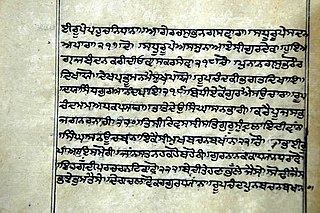
A Hukamnama, in modern-times, refers to a hymn from the Guru Granth Sahib which is given as an injunction, order, or edict to Sikhs. It also refers to edicts issued by the contemporary Takhts. In the historical sense, it was used to refer to an issued commandment, instruction, injunction, order, or edict given by one of the Gurus of Sikhism or their officiated followers and associates during their lives.

Bibi Bhani, also known as Mata Bhani, was the daughter of Guru Amar Das, the third Sikh Guru. She played a central role in the history of Sikhism and is one of the four consorts bestowed with the title of Guru-Mahal.
Gurdwara Mata Sundri is considered to be one of the major historical Gurudwara of the Sikh; it is a landmark on the Mata Sundri road in the heart of Delhi. It is situated behind JP Nayak Hospital, the Gurudwara is a tribute to Mata Sundri, the wife of the 10th Guru – Guru Gobind Singh.
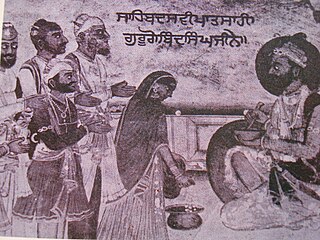
Mātā Jīto, or Ajeet Kaur, was a wife of Guru Gobind Singh.

Kartarpur is a town, near the city of Jalandhar in Jalandhar district in the Indian state of Punjab and is located in the Doaba region of the state. It was founded by the fifth Guru of the Sikhs, Guru Arjan.
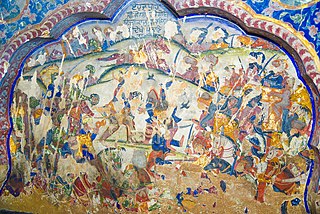
The Battle of Kartarpur occurred on 25 April 1635. It started when the Mughal Empire attacked the town of Kartarpur. The Mughal force was repulsed by the Sikh defenders. The battle occurred in the locality of Kartarpur in present-day Jalandhar district of Indian Punjab.
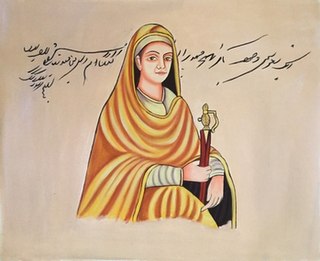
Mātā Sundarī (died 1747, Punjabi: ਮਾਤਾ ਸੁੰਦਰੀ) was a wife of Guru Gobind Singh.
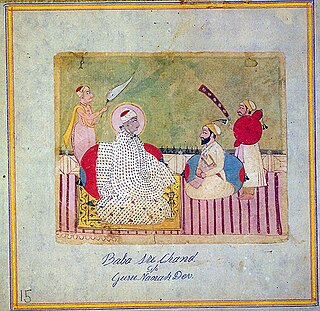
Sri Chand, also referred to as Baba Sri Chandra or Bhagwan Sri Chandra, was the founder of the Udasi sect of ascetic Sadhus. Sikh sources give his life the impressive dates of 8 September 1494 – 13 January 1629, which would have made him 134 years old upon his death.

Pratap Singh Bahadur or Tikka Sahib was the eldest son of Sher Singh, Maharaja of Sikh Empire. His mother was Maharani Prem Kaur.

The Mīnās were a heretical sect of Sikhs that followed Prithi Chand, the eldest son of Guru Ram Das, after his younger brother Guru Arjan was selected by the Guru to succeed him. Prithi Chand would vigorously contest this, attracting a portion of Sikhs to his side who followers of Guru Arjan referred to as ਮੀਣੇ mīṇe, meaning "charlatans," "dissemblers," or "scoundrels." They sustained their opposition to the orthodox line of Gurus through the seventeenth century, and upon Guru Gobind Singh's founding of the Khalsa in 1699, they were declared by him, as well as by Khalsa rahitnamas, as one of the Panj Mel, or five reprobate groups, that a Sikh must avoid. They are occasionally referred to in the more neutral terms Sikhān dā chhotā mel or as the Miharvān sampraday in scholarship.

Mata Nanaki (1598–1678), alternatively spelt as Mata Nanki or with the prefix Bibi/Bebe, was the wife of the sixth Sikh guru, Guru Hargobind and the mother of Guru Tegh Bahadur, the ninth Sikh guru.
Bhai Gaura was the eldest son of Bhai Bhagtu, and was a devotee of Guru Arjan, warrior, and native of Vinjhu, 14 km north of Bathinda, India.
Bhai Balu Hasna was a Sikh preacher and leader of a branch of the Udasi sampradaya. He was the younger brother of Bhai Almast.
Bhai Almast was a Sikh preacher, leader of a branch of the Udasi Sampradaya, and the elder brother of Bhai Balu Hasna, another prominent preacher of the Udasi sect.
















